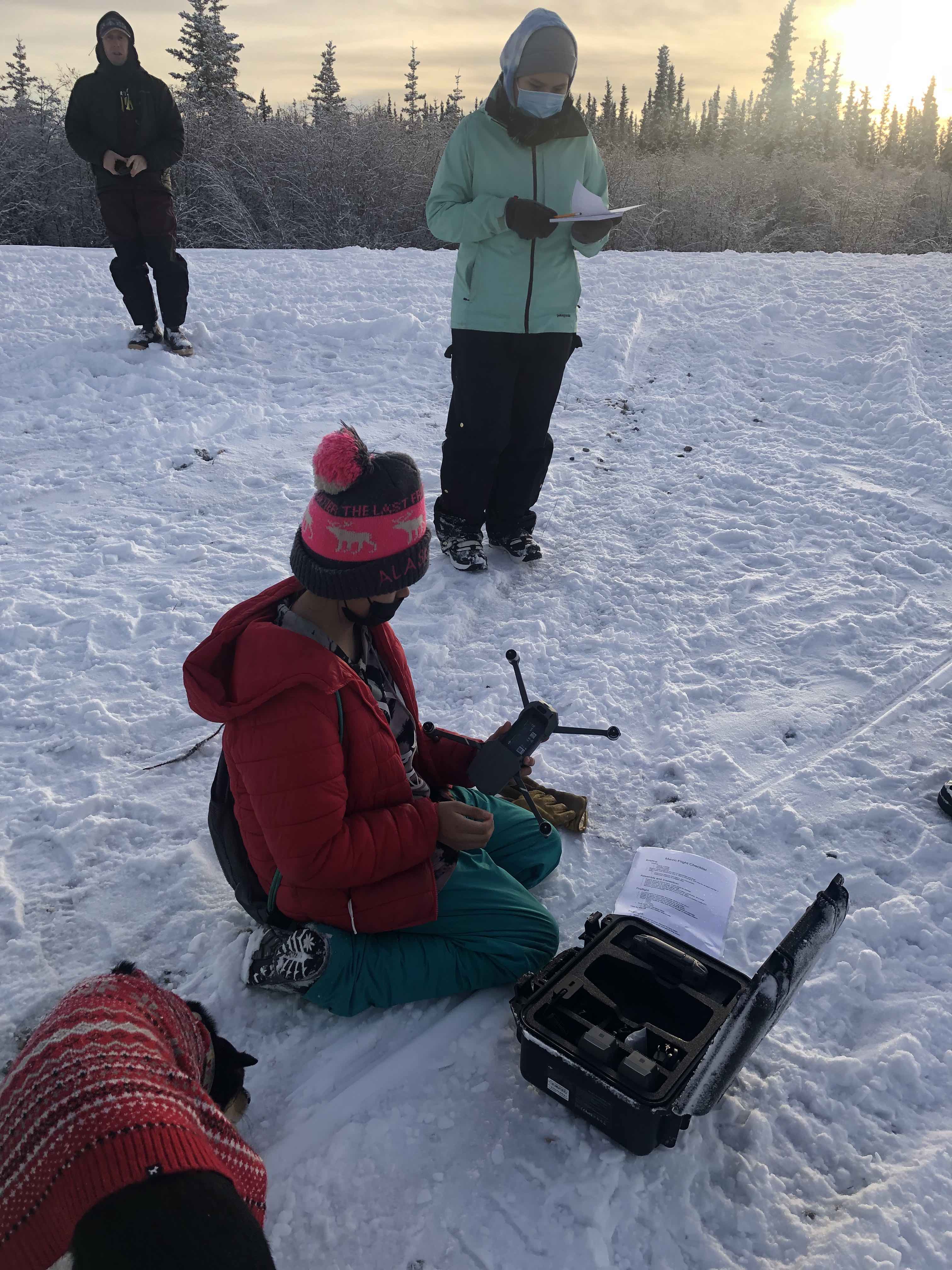UAF scientists help rural students do science with tiny drones
Rod Boyce
907-474-7185
Jan. 14, 2022
The little airborne drone zipped across a lake near the Interior Alaska community of Venetie in late autumn, destined for a patch of white that looked a little less white than the season’s first snow blanketing the area.
Students from the small community’s John Fredson School watched as the visiting scientists from the Alaska Satellite Facility at the University of Alaska Fairbanks Geophysical Institute guided the craft to its investigatory target for a photo.
“It was a star-shaped crack. What is that? Why is that there?” said Helena Buurman of the Alaska Satellite Facility. “We talked it through, and then we went back and some of the locals came out, and one of them said it was a muskrat pushup that fell through the ice when the temperature warmed and that it must have left this shape.”

Chris Arp, a hydrologist at the UAF Water and Environmental Research Center and the lead for Fresh Eyes on Ice, watches as students from the John Fredson School in Venetie, Alaska, prepare a drone for flight.
“The cool part of this,” she said of the collapse of the muskrat’s vegetation pile, “is that we went from observations to science to scratching our heads over the science to needing the local knowledge to complete that story.”
The little drone also had a larger target: Getting kids interested in science.
The visit by Buurman and colleagues from the Alaska Satellite Facility and the Fresh Eyes on Ice program is the first of many planned in several rural Alaska communities. The idea piggybacks on the Fresh Eyes on Ice program, led by the UAF International Arctic Research Center and the Water and Environmental Research Center at the UAF Institute of Northern Engineering.
Fresh Eyes on Ice provided participating communities with a single, more substantial drone to use in gathering data about local ice conditions.
Buurman saw Fresh Eyes on Ice as an opportunity to take an existing NASA grant, which in the past had funded one of UAF's Alaska Summer Research Academy courses, in a different direction. Instead of having rural students come to UAF to attend the academy course, she proposed taking the science to the students and melding drone flight training with the needs of the Fresh Eyes on Ice program.
“NASA is interested in serving underrepresented communities and is interested in getting kids into STEM,” Buurman said. STEM refers to education centered on science, technology, engineering and mathematics.
So she, some colleagues from Fresh Eyes on Ice and a bundle of small ready-to-assemble drone kits headed to Venetie, a community 150 miles north of Fairbanks on the Teedriinjik River (formerly Chandalar). Like many rural Alaska communities, Venetie is disconnected from the state’s road system.

A student at John Fredson School in Venetie, Alaska, works with one of the drone kits provided by the Alaska Satellite Facility through a NASA grant.
The idea had the full support of John Fredson School Principal Terri Mynatt, who also teaches at the K-12 school.
The school now has Fly Fridays during which students fly the drones they assembled. There’s also a crew that goes out each week to fly a mission that consists of photographing the Teedriinjik River from views north, east, south and west.
They also go to Venetie Lake, called Big Lake by local residents.
“At Big Lake, each pilot takes the drone to different heights and distances, takes pictures in all four directions, then lands on the landing pad,” Mynatt said. “We also take notes of the temperature and time of day. Each student has a flight log, and every student in the flight crew does the role of pilot and observer.”
The program has had a big impact.
“This experience has taken our students to a new level of self-confidence and academic success and given them a deeper understanding of scientific research,” Mynatt said. “We had a parent evening so the students could share their experiences and do flight demonstrations for their families.”
ADDITIONAL CONTACT: Helena Buurman, Alaska Satellite Facility, 907-474-7538, hmbuurman@alaska.edu.
NOTE TO EDITORS: Photographs are available at the Geophysical Institute news website. Information about Fresh Eyes on Ice is available here.


